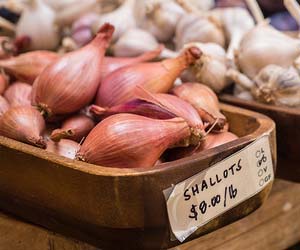Onions

Sweet onions (Allium cepa) are popular among cooks because of their mild taste. They derive their signature flavor from the fact that they contain more water and less sulfur than regular onions.
Some of the best-known sweet onions are Vidalias, named for the specific region in Georgia where they’re grown. Technically, Vidalias are all the same cultivar, known as Granex, and you can grow them at home. Make sure that whichever cultivar you choose is labeled as “short day.” Onions are classified as either short, mid, or long day, depending on how many hours of daylight they need to produce a bulb. Since we are further south, short-day varieties will be the most successful in the fall growing season.
In Florida, onions should be planted from September through December. Choose a sunny spot in your garden with well-drained soil that is high in organic matter. You can grow onions from seed, but it’s quicker and easier to plant “sets.” These small bulbs are ready to transplant and give you a head start for an earlier harvest. Aim to plant your bulbs an inch deep and between four and six inches apart, with a foot between rows. Look for sets at your local garden center or order them from a seed catalog.
Onions need plenty of nutrients, so apply a complete balanced fertilizer when you plant. After that, apply a nitrogen fertilizer monthly and irrigate frequently to promote steady growth. Your onions should be ready to harvest in four to five months, typically when one-quarter of the green tops have fallen over.
Once you’ve harvested your onions, they’ll need to cure. Cure them for a couple of weeks by placing them in a cool, dark, and dry location that is well ventilated to prevent mold. Once they’re cured, shed the tops and roots and store the bulbs in a cool, dry place until you’re ready to enjoy them.
Keep in mind that your homegrown onions may not taste exactly like the ones at the supermarket, since their flavor depends in part on the soil in which they’re grown and the way they’re fertilized.
Shallots

The shallot is a delicious onion with a delicate, mild flavor. Shallots are very similar to green onions but grow in clusters of small bulbs, much like garlic, rather than as individual onions. You can consume both the leaves of shallots and the bulbs.
Fall is a great time to plant your shallots. Shallot bulbs are between three-quarters of an inch and one-and-a-half inches in diameter, and are red, pink, white, gray, or reddish brown. Plant small shallot bulbs about six inches apart, leaving the growing point exposed above the surface of the ground. Harvest in early summer when the leaves turn brown, which will be about 50-60 days after planting.
Save some bulbs for the next season’s garden. Store your dry shallot bulbs in a cool, dry area. Refrigerate green shallot tops and eat them within two weeks.
For advice on growing onions and shallots, contact your county Extension office.
Also on Gardening Solutions
- Cool Season Vegetables
- Five Fall Vegetables for the Home Garden
- Garlic
- Leeks
- Vegetable Gardening: Most Asked Questions
